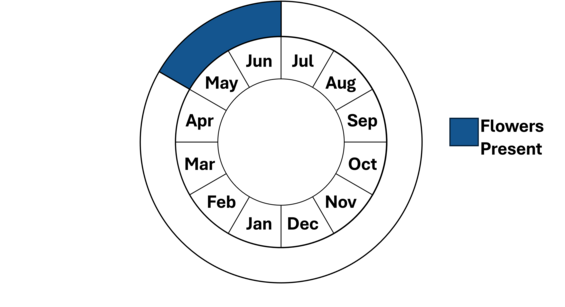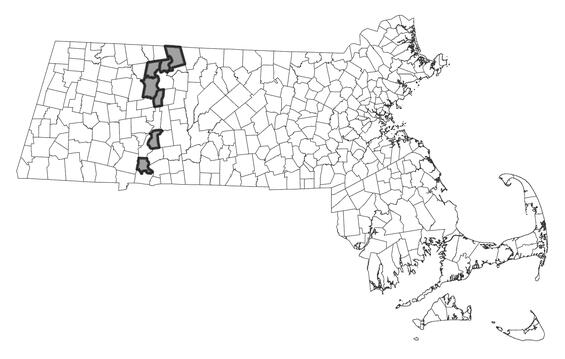- Scientific name: Cerastium nutans
- Species of Greatest Conservation Need (MA State Wildlife Action Plan)
- Endangered (MA Endangered Species Act)
Description
Nodding chickweed is a low-growing (10-50 cm [4–20 in]) annual herb with five-lobed white flowers, and soft, weak stems. It inhabits woodlands and open-canopy forests on non-acidic rocky substrates. The chickweeds (genera Cerastium and Stellaria) are a large group with several Massachusetts species, most of which are introduced. The group is characterized by having oppositely-arranged, simple, entire leaves, and flowers with five deeply notched petals. Upon initial examination, the notched petals may make the flower appear to have 10 petals. Leaves are 1.5-5 cm (9/16-2 in) long and 5-10 mm (0.2-0.4 in) wide, longer and narrower than many others chickweeds. The upper leaves are commonly lance-shaped (broadest near the base and tapering to the tip), whereas the lower leaves are reverse-lance-shaped (broadest near the tip and tapering to the base). Stems, leaves, and flower parts are covered in fine hairs, many of which have bulbous tips (under magnification). These hairs exude a sticky substance that makes the plant sticky to the touch, particularly near the tops of the stems. The small white flowers (petals 4–6 mm long) are produced singly at the tips of stalks that grow from the leaf axils (point where leaves attach to the stem). The flowers typically have 10 stamens; sepals are herbaceous and entire, with hairs that are shorter than the sepal apices. The flower stalks are bent near the top giving the flowers a nodding posture.
Some key characters of nodding chickweed that are useful for distinguishing it from similar species are:
- Leaf dimensions of 1.5-5.0 cm (9/16-2 in.) × 5-10 mm (0.2-0.4 in) wide
- Plants lack runners or subsurface horizontal stems
- Plants lack tufts of tiny leaves in the leaf axils
- Plants are covered with fine hairs
- Sticky secretions from gland-tipped hairs, particularly at the top of the stem
- At least some flowers with stalks that bend at a right angle (or nearly so) just below where the flowers attach
There are eight species of Cerastium in Massachusetts and they are best differentiated using a technical key. Broadly however, field chickweed (C. arvense), mouse-ear chickweed (C. fontanum ssp. vulgare), American field chickweed (C. strictum), and tomentose chickweed (C. tomentosum) can be differentiated from the rare species in that they are all perennials, and have well-developed root systems. The remaining annual congeners each have characters that differentiate them from nodding chickweed: four-stamened chickweed (C. diffusum) has four, not five petals; sticky chickweed (C. glomeratum) has long hairs protruding beyond the tips of the sepals; and the remaining two species, five-stamened chickweed (C. semidecandrum) and European chickweed (C. pumilum), have semi-transparent, ragged tipped sepals, shorter leaves, and often have five stamens.
Life cycle and behavior

Nodding chickweed is an annual species, and unlike some other chickweeds does not spread by producing runners or horizontal underground stems. Nodding chickweed flowers in late spring and early summer.
Population status
Nodding chickweed is listed under the Massachusetts Endangered Species Act as Endangered. All listed species are protected from killing, collecting, possessing, or sale and from activities that would destroy habitat and thus directly or indirectly cause mortality or disrupt critical behaviors. The MassWildlife’s Natural Heritage & Endangered Species Program database has 11 records from 4 counties: Berkshire, Franklin, Hampden, and Hampshire. Seven of these records have been observed within the last 25 years.

Distribution in Massachusetts
1999-2024
Based on records in the Natural Heritage Database
Distribution and abundance
Nodding chickweed is widespread in North America from Quebec to Florida, west to Oregon and the Yukon Territory. It is absent from northern New England and the southwestern United States.
Habitat
In Massachusetts nodding chickweed inhabits rock outcrops, talus slopes, and rocky woods. Information on associated bedrock types is sketchy, but two populations with solid information are located on rocks with near-neutral pH (basalt and sandstone conglomerate) and two historic Berkshire County records are from areas where marble (alkaline pH) bedrock is common. Soil moisture ranges from dry to moist. All occurrences are in forests or woodlands with at least a partially open canopy. The species has never been recorded east of the Connecticut River and most records are from the Connecticut River Valley and Berkshire County.
Healthy habitats are vital for supporting native wildlife and plants. Explore habitats and learn about conservation and restoration in Massachusetts.
Threats
Excessive shading due to canopy closure and competition from exotic invasive or aggressive native plants are potential threats.
Conservation and management
Experimental canopy thinning or other vegetation control may be warranted. All active management of rare plant populations (including invasive species removal) is subject to review under the Massachusetts Endangered Species Act and should be planned in close consultation with MassWildlife’s Natural Heritage & Endangered Species Program.
Contact
| Date published: | April 9, 2025 |
|---|